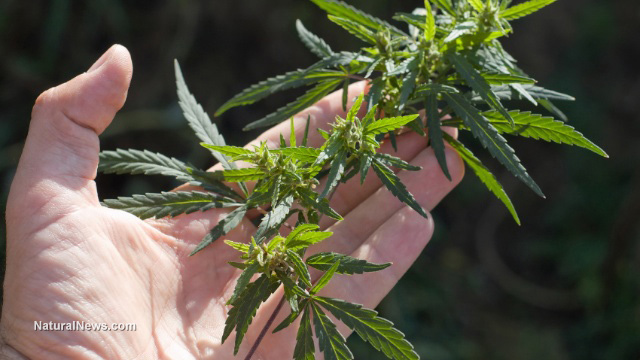Cannabis innovators set out to map the marijuana genome: new information could prevent the sale of falsely advertised bud
Tuesday, May 31, 2016 by: L.J. Devon, Staff Writer
Tags: cannabis, ancient strains, medicinal qualities

(NaturalNews) "Jackpot!" exclaimed Mowgli Holmes, a 43-year-old geneticist with a doctorate in microbiology and immunology from Columbia University. He had just come across an old treasure from the 1930s, something that he could use to restore scientific knowledge regarding the medicinal qualities of cannabis. This treasure was a huge missing piece in his quest to bring transparency to the genome of cannabis, a collection that he could analyze and map out to forever change how entire societies view marijuana.
When marijuana prohibition began sweeping through America in 1937 with the Marijuana Tax Act, attitudes toward cannabis quickly darkened. The plant, and all of its eclectic uses, dropped into the shadows, off the grid, into obscurity. A war was slowly waged against the plant over the next several decades. Cannabis hysteria spread, and all the virtues of the plant became demonized.
Bringing scientific transparency to the cannabis marketplace
In 2013, after spending years in HIV research, chief scientific officer of Phylos Bioscience, Mowgli Holmes, saw an entirely new career path unfolding right in front of him. With Oregon only a year away from legalizing marijuana for recreational use, Holmes saw a new opportunity for research: studying the genome of cannabis."In every other academic field, you have to find the tiniest little corner of the world to study. It's almost impossible to find something nobody else has done, and immediately someone is competing with you," he says. "Here, we have an entire organism that there's basically no body of knowledge on.... This doesn't happen in science, where you have a plant like this that's been cordoned off from research." He reiterated, "There's a whole new industry exploding all around it."
By mapping out the genome of cannabis, he could take cannabis out of the shadows and validate all the cannabis product claims currently circulating. By comparing and differentiating between different strains of bud, the entire cannabis underworld would come out of the dark and into the light of transparency, validating current medicinal claims, while also preventing the sale of falsely advertised buds.
Since cannabis is vilified and outlawed, it's produced in the dark, with no transparency or oversight governing the medicinal quality of the strains produced. Recreational consumers and medical patients buy up cannabis products by simply just trusting the supplier. Many products contain catchy labels that are oftentimes misleading.
Thousands of cannabis strains preserved, their DNA mapped out for future growing specialties
The treasure Holmes discovered had belonged to a legend of the cannabis movement, Ohio lawyer Don Wirtshafter. They met at the Marijuana Business Conference and Expo in Las Vegas in 2014. The treasure is a 1930s collection of cannabis tinctures, representing various ancient strains. Wirtshafter obtained the collection from the wife of a former federal employee who defied cannabis prohibition through the years.With this collection, Holmes could study various strains of U.S. cannabis DNA from before prohibition, to compare it with his ever-increasing database of world cannabis strains. The differentiations he could make would be vital for public knowledge, to bring clarity to the entire marijuana market – from growers, to dispensers, to product manufacturers.
At this point, Holmes has collected nearly 2,000 specimens from around the world. Working at their own Oregon Health and Science University, Holmes and ten other colleagues search for different cannabis strains throughout the world, mostly through word-of-mouth treasure hunts.
By entering the cannabis genome information into his software program and organizing the DNA into clusters, Holmes is able to get a visual representation of how the different strains relate to one another. The most valuable samples have come from museums and collectors from Colombia, Afghanistan, India and Thailand. He is currently trying to gain access to a 2,700-year-old strain from Northern China.
One of Holmes' future goals is to work with growers to create new strains that have specific traits. He also looks forward to mapping the history of human travels by studying the migration of cannabis through history.
As the world's cannabis genome is mapped out, buyers and patients will be able to find the strain that is best suited for them. This will bring extraordinary scientific clarity to the growing cannabis marketplace.
Sources include:
Newsweek.com
Science.NaturalNews.com
Cannabis at FETCH.news
Get independent news alerts on natural cures, food lab tests, cannabis medicine, science, robotics, drones, privacy and more.
Take Action: Support Natural News by linking to this article from your website
Permalink to this article:
Embed article link: (copy HTML code below):
Reprinting this article:
Non-commercial use OK, cite NaturalNews.com with clickable link.
Follow Natural News on Facebook, Twitter, Google Plus, and Pinterest
- Newly released JFK files reveal Pentagon's role in creating Lyme disease and covid in the same lab
- Trump nominates VACCINE ZEALOT Susan Monarez to lead the CDC, sidelining RFK Jr.'s reform efforts
- Obama accused of laundering USAID funds to fuel global protest movements, regime change operations
- Trump's greatest betrayal so far: Accelerating Middle East wars, silencing dissent, and serving Zionist masters
- STARDUST, a secretive Israeli-US startup, plans risky solar geoengineering experiment to BLOCK OUT THE SUN
- Trump shows his true colors
- $2B Roundup verdict: A landmark blow to Bayer and a win for health freedom
- Outrageous government fraud: $312M in COVID loans went to children as young as 9 months old
- Elon Musk: Aliens could be here on Earth RIGHT NOW
- Festive flavors: The sweet history, nutritional profile and health benefits of pecan pie
- Dr. Mike Yeadon releases 15-minute testimony - WATCH - about genocidal intent of COVID “vaccines”
- HUGE: Putin claims 2020 election fraud in U.S. sparked Ukraine war, calls for peace talks with Trump
- SWEET SABOTAGE: CIA's secret war on Soviet sugar revealed in JFK files
- “Forever chemicals” in drinking water drive alarming cancer surge, new study warns
- Chris Rufo finally reveals abuse liberals unleashed on his wife and young kids...
- California's social media censorship law struck down: A victory for free speech or a threat to online safety?
- Reclaim your health: How midlife exercise reverses years of inactivity
- A mysterious startup is developing a new form of solar geoengineering
- Newly released JFK files reveal Pentagon's role in creating Lyme disease and covid in the same lab
- Elon Musk: Aliens could be here on Earth RIGHT NOW
- Reclaim your health: How midlife exercise reverses years of inactivity
- Trump reverses course on Gaza plan, says “nobody is expelling Palestinians”
- EPA advisor admits the agency is funneling billions to climate groups ahead of Trump’s return to White House
- Big Pharma's $8 Billion bribery scheme exposed: how doctors are pushed to prescribe junk science, not heal
- Space war brewing? Russia threatens to destroy Starlink satellites
- A lack of integrity in Academia: Harvard professor found GUILTY of fraudulent research to promote CRT theory
- Survival 101: Effective EMF blocking techniques
- Rep. Nancy Mace introduces bill to ban biological males from female facilities on federal property
- Mike Adams Sermon 66: God will DESTROY ISRAEL for its wickedness
- Pilots report mysterious lights 'moving at extreme speeds' across Oregon skies
- 5 Simple steps to boost your brainpower: How to strengthen executive function in a distracted world
- Historian warns Israel may be entering an “IRREMEDIABLE DECLINE”
- Florida takes a stand: DeSantis proposes permanent ban on mRNA vaccine mandates
- RFK Jr.'s SSRI antidepressant investigation sparks liberal meltdown, exposes Big Pharma's dangerous game
- OpenAI whistleblower who dissented against how the company trained ChatGPT found dead
- Sugarcane extract superior to cholesterol-lowering drugs?
- EPA advisor admits the agency is funneling billions to climate groups ahead of Trump’s return to White House
- The Health Ranger releases “Vaccine Zombie” song and music video, using AI-animated zombies for the music video
- California's social media censorship law struck down: A victory for free speech or a threat to online safety?
- Dr. Mike Yeadon releases 15-minute testimony - WATCH - about genocidal intent of COVID “vaccines”
- The pandemic as a tool for INDOCTRINATION: Understanding “The Indoctrinated Brain” by Dr. Michael Nehls
- Mike Adams releases country western hit single: Goin’ Back in Time is Comin’ Home
- Mike Adams releases music poetry sensation: A Child of God
- RFK Jr. clears key hurdle: Sen. Susan Collins backs controversial HHS nominee, signaling a new era for health policy
- Florida takes a stand: DeSantis proposes permanent ban on mRNA vaccine mandates
- Unpacking the Lies That We’ve Been Fed – new song and music video released by Mike Adams, the Health Ranger
- Mike Adams releases new song and music video: Nothing More Disgusting Than a Globalist
- Congratulations to the FULLY UNVACCINATED as you resisted the COVID-19 PROPAGANDA MACHINE fueled by over $100 BILLION
- “Why we influenced the 2020 elections”: Facebook files reveal the coordinated effort to bury the Hunter Biden laptop story
- Michigan sheriff announces criminal investigation into 2020 election crimes, Dominion Voting Systems
- Israeli soldiers accused of even more torture and abuse in the West Bank
- Migrants are taking advantage of recent hurricanes to scam residents and loot their homes
- House Intelligence Committee calls for the ARREST and PROSECUTION of Dr. Anthony Fauci
- Peter Rost exposes Big Pharma corruption in his book “The Whistleblower: Confessions of a Healthcare Hitman”
- Red Cross issues warning to stop blood plasma donations from vaccinated people
- Scientists confirm: GENIUS brain function can be spontaneously unleashed in humans without any apparent cause
- EPA advisor admits the agency is funneling billions to climate groups ahead of Trump’s return to White House
- HYSSOP: What research reveals about the health benefits of this ancient holy herb
- Two containers with completed ballots fall out of truck in Florida
- Fully vaccinated about to see “tsunami” of illness and death, warns virologist
- Global leaders unite to clamp down on “misinformation” with UN-backed Cascais Declaration
- BREAKING: 2025 NDAA authorizes mandatory military draft of WOMEN across America… as Pentagon pursues global NUCLEAR war with both Russia and China at the same time
- Michael Yon warns of a ZIONIST TAKEOVER in Trump’s second administration
- BOMBSHELL: DNA testing kits are a SCAM to develop ethnic-specific bioweapons
- Ozempic and Wegovy weight loss drugs are injectable LIZARD VENOM PEPTIDES that may unleash a devastating wave of organ failure… side effects align with symptoms of SNAKE BITES
- Israeli soldiers accused of even more torture and abuse in the West Bank
- These 13 countries just signed an agreement to engineer a global FAMINE by destroying food supply
- NASA admits that climate change occurs because of changes in Earth’s solar orbit, and NOT because of SUVs and fossil fuels
- RFK Jr. clears key hurdle: Sen. Susan Collins backs controversial HHS nominee, signaling a new era for health policy
- Sermon 30: How Jesus reveals Caesar’s FAKE CURRENCY and FALSE AUTHORITY
- Coriander seeds: Ancient medicine backed by modern science
- Arizona officials claim Maricopa County needs 10-13 days to tabulate results of the election
Science News & Studies
Medicine News and Information
Food News & Studies
Health News & Studies
Herbs News & Information
Pollution News & Studies
Cancer News & Studies
Climate News & Studies
Survival News & Information
Gear News & Information
News covering technology, stocks, hackers, and more



"Big Tech and mainstream media are constantly trying to silence the independent voices that dare to bring you the truth about toxic food ingredients, dangerous medications and the failed, fraudulent science of the profit-driven medical establishment.
Email is one of the best ways to make sure you stay informed, without the censorship of the tech giants (Google, Apple, Facebook, Twitter, YouTube, etc.). Stay informed and you'll even likely learn information that may help save your own life."
–The Health Ranger, Mike Adams












































